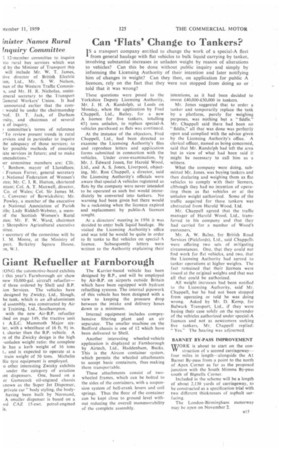Can 'Flats' Change to Tankers?
Page 49

If you've noticed an error in this article please click here to report it so we can fix it.
Is a transport company entitled to change the work of a special-A fleet from general haulage with flat vehicles to bulk liquid carrying by tanker, involving substantial increases in unladen weight by reason of alterations to vehicles? Can this be done without public inquiry and simply by informing the Licensing Authority of their intention and later notifying him of changes in weight? Can they then, on application for public A licences, rely on the fact that they were not stopped from doing so or told that it was wrong?
These questions were posed to the Yorkshire Deputy Licensing Authority, Mr. J. H. A. Randolph, at Leeds on Monday, when the application by Fred Chappell, Ltd., Batley, for a new A licence for five tankers, totalling 454 tons unladen, to replace special-A vehicles purchased as flats was continued. At the instance of the objectors, Fred Chappell, Ltd., had been directed to examine the Licensing Authority's files and reproduce letters and application forms submitted in connection with the vehicles. Under cross-examination, by Mr. J. Edward Jones, for Harold Wood, Ltd., and A. S. Jones, Liverpool, objecting, Mr. Ron Chappell, a director, said the Licensing Authority's officials were aware that special-A vehicles registered as flats by the company were never intended to be operated as such but would immediately be converted into tankers. No warning had been given but there would be a reckoning when the licences expired and replacement by public-A licences sought. At a directors' meeting in 1956 it was decided to enter bulk liquid haulage. He visited the Licensing Authority's office and was told he -would be quite in order to fit tanks to fiat vehicles on special-A licence. Subsequently letters were Written to the Authority explaining their
intentions, as it had been decided to invest £40,0004,50,000 in tankers.
Mr. Jones suggested that to order a tanker and temporarily replace the tank by a platform, purely for weighing purposes, was nothing but a "fiddle." Mr. Chappell said there had been no " fiddle," all that was done was perfectly open and complied with the advice given by the Licensing Authority's office. A clerical officer, named as being concerned, said that Mr. Randolph had left the area but in view of what had been said it might be necessary to call him as a witness. What the company were doing, submitted Mr. Jones, was buying tankers and then declaring and weighing them as flat vehicles to comply with their licences, although they had no intention of operating them as flat vehicles or at the unladen weight authorized. Some of the traffic acquired for these tankers was abstracted from Harold Wood, Ltd. Mr. Chappell agreed that the traffic manager of Harold Wood, Ltd., transferred to his company and that they had carried for a number of Wood's customers. Mr, A. W. Balne, for British Road Services (Pickfords), Ltd., said Chappell% were offering two sets of mitigating circumstances. One, that they could not find work for flat vehicles, and two, that the Licensing Authority had agreed to tanker operations at higher weights. The fact remained that their licences were issued at the original weights and that was all that could be authorized. All weight increases had been notified to the Licensing Authority. said* Mr. Chappell, but he had not been stopped from operating or told he was doing wrong, Asked by Mr. D. Kemp, for Bulwark Transport. Ltd., if they were basing their case solely on the surrender of the vehicles authorized under special-A licences and not as newcomers seeking five tankers, Mr. Chappell replied: "Yes." The hearing was adjourned.
BARNET BY-PASS IMPROVEMENT
WORK is about to start on the construction of a second carriageway— four miles in length—alongside the Al Barnet By-pass from a point to the north of Apex Corner as far as the proposed junction with the South Mimms By-pass south of Bignells Corner. Included in the scheme will be a length of about 2,130 yards of carriageway, to be constructed as a specification trial with two different thicknesses of asphalt surfacing. The London-Birmingham motorway may be open on November 2.




























































































































































